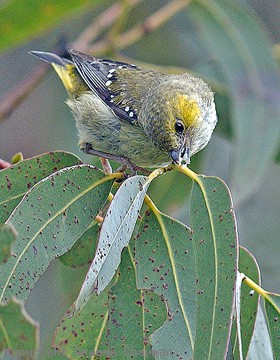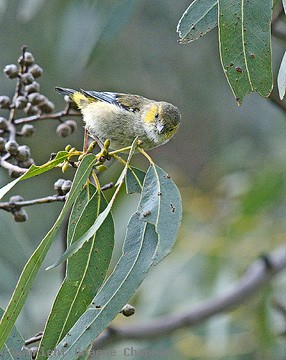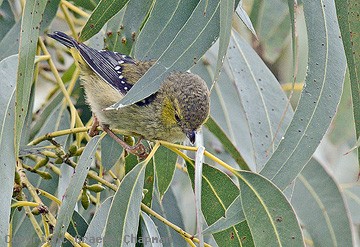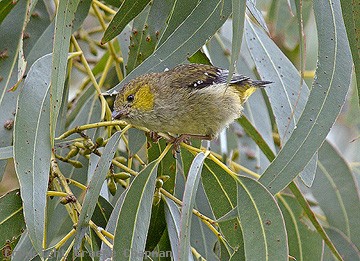Australian BirdsForty-spotted Pardalote
|
Forty-spotted Pardalotes once had a much wider range in eastern Tasmania than at present - now they are restricted to Flinders Island (very few), Maria Island, Bruny Island and adjacent parts of the mainland just south of Hobart. What is it about these places that allows forty-spots to hang in there? are they warmer in winter? it will almost certainly be connected with food supply. Note that their closest relative the Striated Pardalote (form striatus) is one of a group of Tasmanian birds that migrate to the mainland to escape the Tasmanian winter.
The forty-spots I photographed fed in a different part of the tree to the Striated Pardalotes that were there - maybe they have different food preferences. The best places to see Forty-spots are either at the Peter Murrell Reserve near Blackman's Bay, just S of Hobart, or on Bruny Island.
All these pictures were taken at "Inala" a great little farmstay property on south Bruny Is. run by an expert host and guide, Dr Tonia Cochran. More often than not Forty-spots feed high in the tree canopies but at Inala, it was easy to get within camera range of birds feeding quite low on manna, an exudate of the favoured food tree Eucalyptus viminalis. They are quiet little birds - apart from the constant contact calls given by the fledgelings and the click of the bills of the adults as they fed in almost frenzied fashion through the foliage, I hardly ever heard the main territorial call which to me is a softer, quicker version of the call of the local Striated Pardalotes (listen on David Stewart's CD "Australian Bird Calls - Tasmania"). Contrary to some published information, it is nothing like the call of a Spotted Pardalote, even a Tassie Spotted Pardalote. Forty-spotteds nest mainly in tree hollows so they need mature trees for this and there will always be competition with other species. The nest hollow in pic 571223D at Peter Murrell Reserve was about 10 m high - a rather large entrance for a pardalote. The pardalotes were constantly pestered by a pair of Eastern Rosellas trying to chew their way in to the hollow. In addition to this, whenever the pardalotes landed outside the nest in the tree, they were immediately attacked by an aggressive New-holland Honeyeater which was feeding in the foliage. After one of these attacks, the poor pardalote landed on a branch below right in front of me but unfortunately the one picture I was able to take has head movement.(571222D)
|

571201-D ... Forty-spotted Pardalote, feeding on manna, its favourite food. |

571202-D ... Forty-spotted Pardalote |

571203-D ... Forty-spotted Pardalote |

571204-D ... Forty-spotted Pardalote |
